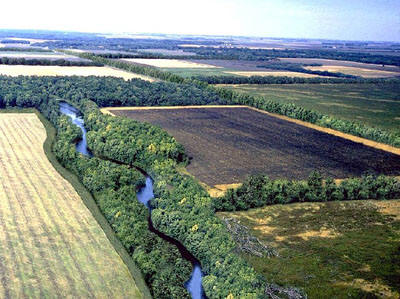Digging Deeper: Habitat Degradation and Human Activity
Habitat encroachment, fragmentation, and destruction has produced a plethora of problems. Habitat destruction is a leading cause of species endangerment. Habitat encroachment increases the contact between human populations and animal populations. Shrinking habitat and accessible sources of food from expanding urban and suburban land use have brought animals and humans into conflict. The loss of tiger prey and presence of livestock have increased attacks on villagers living near tiger habitat in India. Alligators in homeowners backyards is becoming a more frequent site in Florida as urban sprawl invades the state's wetlands. Deer are a nuisance in many suburban areas, destroying gardens and posing a threat to motorists.
Habitat encroachment is responsible for the recent emergence of diseases like Ebola as a threat to humans. Intact habitats tend to inhibit the spread of infectious agents. Damaged, altered, and degraded habitats trigger the spread of new and existing diseases to humans. A 2005 United Nations Global Environment Outlook Year Book 2004/5 reported that the deadly Nipah virus, normally found in Asian fruit bats, is believed to have passed over to humans. Land clearance for palm plantations brought bats in contact with swine, and then humans as their habitat shrunk. The geographic range and seasonality of mosquito-borne diseases like malaria and dengue fever, are very sensitive to changes in climate.
Illegal logging is the
greatest threat to the survival of the orangutan. Native to the
Indian Ocean islands of Sumatra, it is estimated that no more that
60,000 wild orangutans are left worldwide, half the population that
existed a mere 10 years ago.
Forest fires, poaching and conversion of jungles to palm plantations
have also decimated their populations. Living in trees, the great apes
feed on insects and fruits, and in turn, disperse seeds that regenerate
the tropical forests. In spite of government declarations to curb
illegal logging, environmental activists blame political
corruption, and of will and insufficient resources to halt the
multibillion dollar illegal logging activity.
Human conflict has deviated habitats and threatened biodiversity in many regions, especially Africa. But remarkably, some have managed to survive. Listen to NPR's report "After Sudan's Civil War, Where The Wild Things Are" and learn the region is hoping to capitalize on eco-tourism.
Wildlife Corridors
Wildlife require large areas to seek out food, mates,
and nesting sites. Habitat fragmentation restricts
wildlife movement resulting in overcrowding, over
exploitation of resources and species endangerment.
Scientists are attempting to preserve wildlife by
creating corridors between fragmented portions of
habitat. Wildlife corridors allow young animals to seek
new territory and maintain gene flow between individual
habitats thus improving species fitness. Only recently
have scientists been able to show that wildlife
corridors work.
Figure DD.1 Wildlife corridors connect critical habitats in the agricultural heartland of Iowa. (Courtesy NRCS)
Wildlife corridors like those seen here in Iowa permit animals to exploit a variety of resources without having to cross unfriendly terrain like roads, lawns, or barren farm fields.
The Terai Arc is a fifty year effort to reconnect 11 national parks in India and Nepal with one continuous corridor of protected areas. Preliminary data from the Khata corridor between Nepal's Royal Bardia National Park and the Katarniaghat Wildlife Sanctuary of India show use by tigers and elephants. The presence of Spotted Deer and Wild Boar hoof prints provide additional evidence of corridor use.
